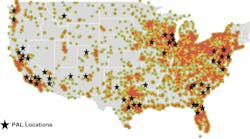The language of trucking was spun like a landlubber's yarn from the language of ships and the sea. Truck operators, their hands on wheels, move up and down the Interstates today hauling cargo for shippers from dock to dock and tracking the transfer of freight in log books and manifests that Captain Cook himself would have understood.
Decades after the launch of this land-bound shipping industry, truckers may borrow still another concept from their sailing counterparts, the sails themselves. Kenworth and a design firm called Aero Works have been testing a new “boat tail” attachment for the back of trailers.
The inflatable tail is the brainchild of Lee Telnack, president of Aero Works, which currently designs sails for boats. This device has a rather different relationship with the wind, however. It is intended to boost fuel efficiency by reducing the air turbulence and drag created in the wake of tractor-trailer combinations.
“Since I moved to Washington State, I've been designing sails for boats,” says Telnack, “My background is in transportation design, though; from 1988-1991, I was part of Ford's Advanced Concepts group. Boat tails for trucks aren't a totally new idea, but this approach is. And we have a patent for this design.”
Telnack's device is made of the same material used in Zodiac inflatable boats. Like the lightweight watercraft, the boat tail is rigid and strong when it is filled with air, in this case air drawn from the vehicle's air brake system. When the trailer doors are opened, however, it splits in half and collapses against the sides of the trailer.
“Our design attaches to the door hinges on rear-opening trailers,” he explains. “Because the inflated device is rigid, we can make sure it doesn't obscure the view of tail lights. We can also incorporate LED lights right on the boat tail itself.
“In addition to our wind tunnel testing of models and full-sized prototypes at the University of Washington's facility, we've done some 500-mile highway tests with Kenworth to evaluate performance and measure the impact on fuel efficiency,” Telnack notes. “These road tests have been conducted strictly according to SAE standards, with every possible variable controlled to isolate the effect of the boat tail on fuel consumption. So far, the tractor-trailer combination equipped with our boat tail has used 3.5% less fuel than an identical tractor paired with a standard trailer.”
“Aero Works' device could solve some of the problems that kept past attempts from being practical,” says Jim Bechtold, Kenworth's chief engineer. “It seems to deliver improvements in fuel efficiency that are significant enough to make a difference. Most fleets today, for instance, will make a spec'ing decision based on fuel efficiency improvements of just 1% to 1.5%.
“There are still issues of safety and practicality to address, though, such as how to inflate the boat tail and yet make sure that air for braking is kept a priority and the braking system is safeguarded. The costs versus benefits equation also has to be worked out,” Bechtold adds.
For now, Aero Works is continuing to refine their design, talking to interested trailer manufacturers and planning for a second round of highway testing with fleets, according to Telnack. “This concept may also have application as a cab extender to reduce turbulence between the tractor and trailer or as side skirting below the trailer,” he says. “We see lots of opportunities.”
Fleets interested in participating in road tests of the Aero Works boat tail are invited to contact the company directly to learn more by going to the Aero Works web site at www.aeroworks.com or calling: 360-352-0654. Sail ho!


